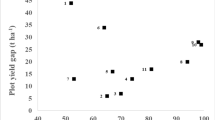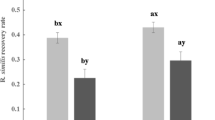Abstract
Direct-seeding or no-till is defined as planting directly into residue of the previous crop without tillage that mixes or stirs soil prior to planting. No-till reduces soil erosion, improves soil structure and organic matter, and reduces fuel inputs. No-till is widely used in cereal production in Australia, Canada, Argentina, and Brazil, but has not been widely adopted in Europe and the Pacific Northwest of the U.S. One of the limitations is that root diseases may increase with a reduction in tillage. This paper discusses the importance and management of take-all, Fusarium dryland foot rot, Rhizoctonia bare patch and root rot, and Pythium root rot in dryland cereal production systems, and how they are influenced by changes in tillage practices. To address this challenge, specifically with Rhizoctonia and Pythium, our research group has (1) developed classical and molecular techniques to detect and quantify Rhizoctonia and Pythium spp. from the soil to assess disease risk; (2) studied the disease dynamics of root disease during the transition from conventional to no-till; (3) developed greenhouse methods to screen germplasm for tolerance or resistance to Pythium and Rhizoctonia, and (4) using GPS and geostatistics, has examined the spatial distribution of R. solani and R. oryzae at a field scale up to 36 ha, across a number of crop rotations and years. By a combination of ecological, epidemiological, field, and laboratory studies, we hope to provide growers with a set of disease management tools to permit the economical and sustainable production of dryland cereals without degradation of the soil resource.
Similar content being viewed by others

References
Allain-Boule N, Tweddell R, Mazzola M, Bélanger R, Lévesque CA (2004) Pythium attrantheridium sp nov.: Taxonomy and comparison with related species. Mycological Research 108: 795–805
Bailey KL, Gossen BD, Lafond GP, Watson PR, Derksen DA (2001) Effect of tillage and crop rotation on root and foliar diseases of wheat and pea in Saskatchewan from 1991–1998: Univariate and multivariate analyses. Canadian Journal of Plant Science 81: 789–803
Bailey KL, Mortensen K, Lafound GP (1992) Effects of tillage systems and crop rotations on root and foliar diseases of wheat, flax, and peas in Saskatchewan. Canadian Journal of Plant Science 72: 583–591
Chamswarng C, Cook RJ (1985) Identification and comparative pathogenicity of Pythium species from wheat roots and wheat-field soils in the Pacific Northwest. Phytopathology 75: 821–827
Conservation Technology Information Center (2004) National Crop Residue Management Survey Conservation Tillage Data. [on-line] http://www.ctic.purdue.edu/CTIC/CRM. html. Accessed August 22, 2005
Cook RJ, Schillinger WF, Christensen NW (2002a) Rhizoctonia root rot and wheat take-all in diverse direct seed cropping systems. Canadian Journal of Plant Pathology 24: 349–358
Cook RJ, Sitton JW, Haglund WA (1987) Influence of soil treatments on growth and yield of wheat and implications for control of Pythium root rot. Phytopathology 77: 1172–1198
Cook RJ, Sitton JW, Waldher JT (1980) Evidence for Pythium as a pathogen of direct-drilled wheat in the Pacific Northwest. Plant Disease 64: 1061-1066
Cook RJ, Veseth RJ (1991) Wheat Health Management. American Phytopathological Society Press, St. Paul, MN. 151 pp
Cook RJ, Weller DM, El-Banna AY, Vakoch D, Zhang H (2002b) Yield responses of direct-seed wheat to fungicide and rhizobacteria treatments. Plant Disease 87: 780–784
Dao TH (1993) Tillage and winter wheat residue management effects on water infiltration and storage. Soil Science Society of America Journal 57: 1586–1595
De Cock AWAM, Lévesque CA (2004) New species of Pythium and Phytophthora. Studies in Mycology 50: 481–487
Douglas JT, Goss MJ (1982) Stability and organic matter content of surface soil aggregates under different methods of cultivation and in grassland. Soil Tillage Research 2: 155–175
Duchateau K (2003) Organic Farming in Europe. Statistics in Focus. Environment and Energy. Theme 8 2/2003. Catologue Number KS-NQ-03–002-EN-N, Eurostat, European Communities
European Conservation Agriculture Federation. Situation of Conservation Agriculture in Europe. http://www.ecaf.org/ Accessed 3 March 2006
Greene C and Dobbs T (2001) Organic Wheat Production in the United States: Expanding Markets and Supplies. in: Wheat Yearbook WHS-2001, U.S. Department of Agriculture, Economic Research Service, pp. 31–37
Higginbotham RW, Kidwell KK, Paulitz TC (2004a) Virulence of Pythium species isolated from wheat fields in eastern Washington. Plant Disease 88: 1021–1026
Higginbotham RW, Kidwell KK, Paulitz TC (2004b) Evaluation of adapted wheat cultivars for tolerance to Pythium root rot. Plant Disease 88: 1027–1032
Inglis DA, Cook RJ (1986) Persistence of chlamydospores of Fusarium culmorum in wheat field soils of eastern Washington. Phytopathology 76: 1205–1208
Ingram DM, Cook RJ (1990) Pathogenicity of four Pythium species to wheat, barley, peas and lentils. Plant Pathology 39: 110–117
Isaaks EH, Srivastava RM (1989) An Introduction to Applied Geostatistics. Oxford University Press, New York
Lévesque CA, de Cock WAM (2004) Molecular phylogeny and taxonomy of the genus Pythium. Mycological Research 108:1363–1383
Levesqué CA, Rahe J (1992) Herbicide interactions with fungal root pathogens, with special reference to glyphosate. Annual Review of Phytopathology 30: 579–602
Lindstrom MJ, Koehler FE, Papendick RI (1974) Tillage effects on fallow water storage in the eastern Washington dryland region. Agronomy Journal 66: 312–316
MacNish GC (1985) Methods of reducing rhizoctonia patch of cereals in Western Australia. Plant Pathology 34:175–181
Mircetich SM, Kraft JM (1972) Efficiency of various selective media in determining Pythium populations in soil. Mycopathologia et Mycologia Applicata 88: 1–11
Moore KJ, Cook RJ (1984) Increased take-all of wheat with direct-drilling in the Pacific Northwest. Phytopathology 74:1044–1049
Ogoshi A, Cook RJ, Bassett EN (1990) Rhizoctonia species and anastomosis groups causing root rot of wheat and barley in the Pacific Northwest. Phytopathology 80: 784–788
Ostro B, Chestnut L (1998) Assessing the health benefits of reducing particulate matter air pollution in the United States. Environmental Research 79: 94–106
Pankhurst CE, McDonald HJ, Hawke BG (1995) Influence of tillage and crop rotation on the epidemiology of Pythium infections on wheat in a red-brown earth of South Australia. Soil Biology and Biochemistry 27: 1065–1073
Pankhurst CE, McDonald HJ, Hawke BG, Kirkby CA (2002) Effect of tillage and stubble management on chemical and microbiological properties and the development of suppression towards cereal root disease in soils from tow sites in NSW, Australia. Soil Biology and Biochemistry 34: 833–840
Papendick RI (1996) Farming systems and conservations in the Northwest Wheat Region. American Journal of Alternative Agriculture 11: 52–57
Papendick RI (2004) Farming with the Wind II: Wind Erosion and Air Quality Control on the Columbia Plateau and Columbia Basin. University Publishing, Washington State University, Pullman, WA
Papendick RI, Cook RJ (1974) Plant water stress and development of Fusarium [roseum] foot rot in wheat subjected to different cultural practices. Phytopathology 64: 358–363
Paulitz TC (2002) First report of Rhizoctonia oryzae on pea. Plant Disease 86: 442
Paulitz TC and Adams K (2003) Composition and distribution of pythium communities from wheat fields in eastern Washington State. Phytopathology 93: 867–873
Paulitz TC, Rossi R (2004) Spatial distribution of Rhizoctonia solani and Rhizoctonia oryzae at three different scales in direct-seeded wheat. Canadian Journal of Plant Pathology 26: 419
Paulitz TC, Schroeder KL (2005) A new method for quantification of Rhizoctonia solani and R. oryzae from soil. Plant Disease 89:767–772
Paulitz TC, Smiley R, Cook RJ (2002a) Insights into the prevalence and management of soilborne cereal pathogens under direct seeding in the Pacific Northwest, U.S.A. Canadian Journal of Plant Pathology 24: 416–428
Paulitz TC, Smith J, Kidwell K (2002b) Virulence of Rhizoctonia oryzae on wheat and barley cultivars from the Pacific Northwest. Plant Disease 87: 51–55
Paulitz TC, Adams K, Mazzola M (2003a) Pythium abappressorium- a new species from eastern Washington. Mycologia 95: 80–86
Paulitz TC, Zhang H, Cook RJ (2003b) Spatial distribution of Rhizoctonia oryzae and Rhizoctonia root rot in direct-seeded cereals. Canadian Journal of Plant Pathology 25: 295–303
Pumphrey FV, Wilkins DE, Hane DC, Smiley RW (1987) Influence of tillage and nitrogen fertilizer on Rhizoctonia root rot (bare patch) of winter wheat. Plant Disease 71:125–127
Ramsey NE (2001) Occurrence of take-all on wheat in Pacific Northwest cropping systems. M.S. Thesis. Washington State University, Pullman, WA
Rovira AD (1986) Influence of crop rotation and tillage on Rhizoctonia bare patch of wheat. Phytopathology 76: 669–673
Schillinger WF, Paulitz TC (2006) Reduction of Rhizoctonia bare patch in wheat with barley rotations. Plant Disease 90: 302–306
Schroeder KL (2004) The Dynamics of Root Diseases of Wheat and Barley in the Transition from Conventional Tillage to Direct Seeding. PhD Dissertation, Washington State University, Pullman. WA
Schroeder KL, Okubara PA, Tambong JT, Lévesque CA, Paulitz TC (2006) Identification and quantification of pathogenic Pythium spp. from soils in eastern Washington using real-time polymerase chain reaction. Phytopathology 96: 637–647
Schroeder KL, Paulitz TC (2002) Development of Rhizoctonia root rot of barley in soils from conventional and no-till fields. Phytopathology 92: S74
Schwartz J, Neas LM (2000) Fine particles are more strongly associated than course particles with acute respiratory health effects in schoolchildren. Epidemiology 11: 6–10
Smiley RW, Collins HP, Rasmussen PE (1996) Diseases of wheat in long-term agronomic experiments at Pendleton, Oregon. Plant Disease 80: 813–820
Smiley RW, Ogg AG, Cook RJ (1992) Influence of glyphosate on Rhizoctonia root rot, growth, and yield of barley. Plant Disease 76: 937–942
Smiley RW, Patterson L-M (1996) Pathogenic fungi associated with Fusarium foot rot of winter wheat in the semiarid Pacific Northwest USA. Plant Disease 80: 944–949
Smiley RW, Gourlie JA, Easley SA, Patterson LM, Whittaker RG (2005a) Crop damage estimates for crown rot of wheat and barley in the Pacific Northwest. Plant Disease 89: 595–604
Smiley R, Seimens M, Gohlke T and Poore J (2005b) Small grain acreage and management trends for eastern Oregon and Washington. 2005 Dryland Agricultural Research Annual Report, Oregon State University Special Report 1061
Smiley RW, Uddin W (1993) Influence of soil temperature on Rhizoctonia root rot (R. solani AG-8 and R. oryzae) of winter wheat. Phytopathology 83: 777–785
Smith JD, Kidwell KK, Evans MA, Cook RJ, Smiley RW (2002) Evaluation of spring cereal grains and wild Triticum relatives for resistance to Rhizoctonia solani AG 8. Crop Science 43: 701–709
Washington Wheat Commission (2004) Washington Wheat Facts [on-line]. Available from: http://www.wawheat.com/pdf/2004WFeBook.pdf Accessed August 22, 2005
Weller DM, Cook RJ, MacNish G, Bassett EN, Powelson RL, Petersen RR (1986) Rhizoctonia root rot of small grains favored by reduced tillage in the Pacific Northwest. Plant Disease 70: 70–73
Weller DM, Raaijmakers JM, McSpadden Gardener BB, Thomashow LS (2002) Microbial populations responsible for specific soil suppressiveness to plant pathogens. Annual Review of Phytopathology 40:309–348
Willer H, Yussefi M, eds. (2005) The World of Organic Agriculture - Statistics and Emerging Trends 2005. International Federation of Organic Agriculture Movements (IFOAM), Bonn, Germany
Acknowledgements
This paper was from a talk presented at a COST860 SUSVAR Workshop on “Beneficial Interactions Below Ground”, 7–9 March, 2005 at les Geneveys-sur-Coffrane, Switzerland. Thank you to Dr. Susanne Vogelgsang for information on organic production in Europe.
Author information
Authors and Affiliations
Corresponding author
Rights and permissions
About this article
Cite this article
Paulitz, T.C. Low Input No-till Cereal Production in the Pacific Northwest of the U.S.: The Challenges of Root Diseases. Eur J Plant Pathol 115, 271–281 (2006). https://doi.org/10.1007/s10658-006-9023-6
Accepted:
Published:
Issue Date:
DOI: https://doi.org/10.1007/s10658-006-9023-6
Keywords
- Direct-seed
- no-till
- cereal cropping systems
- soilborne fungal pathogens of wheat and barley
- Pythium root rot
- Rhizoctonia bare patch and root rot
- Fusarium crown rot
- take-all
- Gaeumannomyces graminis var tritici
- Rhizoctonia solani
- Rhizoctonia oryzae
- Ceratobasidium spp
- Fusarium culmorum
- Fusarium pseudograminearum
- Pythium spp.
- real-time quantitative PCR
- ITS sequencing
- spatial analysis
- Global Positioning System



